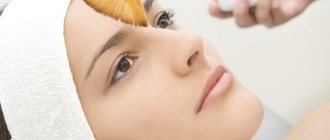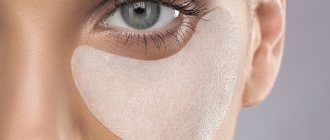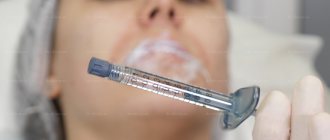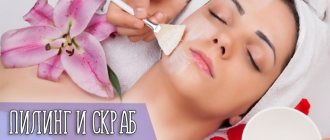The upper layers of the skin are represented by a porous epidermis, which must be regularly renewed. The rate of renewal decreases with age and under the influence of unfavorable factors. As a result, particles of the epidermis layer on top of each other, begin to clog pores and can provoke the proliferation of pathogenic microorganisms.
To regularly cleanse the skin at home, many people choose chemical peels with acids. They dissolve the upper dead layer of cells, restoring cellular nutrition and respiration. At home, you can also use mechanical peelings with exfoliating microparticles. You can also cleanse your facial skin with professional cleansing. It is performed by an experienced cosmetologist. Highly concentrated acids are also used only in professional products that are available to beauty salon specialists or dermatologists.
Difference between facial cleansing and peeling
To understand whether facial cleansing before peeling is possible, you need to find out what each procedure is.
Cleaning is a superficial action on the skin that involves fingers and special tools. The task is to remove fat and dirt accumulations and acne formations from the pores.
During the procedure, measures are taken to prevent infection and cosmetic blemishes are eliminated. It is suitable for all skin types and is recommended for getting rid of hormonal skin problems in teenagers.
Expert opinion
Elena Apostolyuk
Cosmetologist
Peeling is an intensive type of cleansing in which the skin is exposed to chemicals. The goal is to remove dead tissue, rejuvenate and heal the skin, and strengthen the capillary network. It is recommended for patients over 30 years of age.
At an earlier age, it is undesirable because it can negatively affect the protective abilities of the skin, which will increase susceptibility to inflammatory and other diseases.
Peeling is classified according to the depth of the skin tissue affected:
- superficial - based on non-concentrated fruit acids, has a gentle effect on the skin, dissolves exclusively dead outer skin cells;
- middle - chemicals penetrate into the middle layers of the epidermis, where they stimulate exfoliation processes, accelerate tissue regeneration, improve the synthesis of collagen and elastin;
- deep – effectively relieves symptoms of aging, wrinkles, scars and age spots, implies complete dissolution of epidermal tissues (aggressive substances do not affect only the thin layer where cell growth points are located).
From the above it follows that the procedures differ in:
- depth of impact on skin tissue;
- execution method;
- age recommendations;
- severity and duration of the result.
You should talk in more detail about the main differences between cleansing procedures:
- Depth of impact. When cleaning, only the superficial layers of the skin are affected, so the impact is less stressful. Mud accumulations, excess secretions of the sebaceous glands, acne and other pathological formations are removed. When peeling, the effect is deeper, it reaches the middle and deep layers of the epidermis. This is possible thanks to the use of hardware methods and aggressive drugs based on organic acids.
- Age recommendations. Superficial facial cleansing can be done at any age. With peeling, everything is not so clear. If there are indications, the cosmetologist will even accept a 14-year-old child. Medium-intensity peeling begins at the age of 30–35 years, but deep peeling is prescribed no earlier than 45–50 years.
- Execution method. Cleaning is a mechanical process. The cosmetologist squeezes out skin formations with fingers wearing sterile gloves or with special instruments. Aggressive acid-based drugs are not used. Peeling is a chemical or hardware process, and this is its main difference from cleaning. In addition to acids, devices can be used: ultrasonic, laser.
- Expressiveness of the result. The main advantage of peeling is a more noticeable result. Cleaning is needed as a gentle procedure for minor skin defects; it copes well with comedones, blackheads, and sebaceous plugs. It not only solves all of the above problems, but also removes age spots, slows down the aging process, makes the skin fresher and healthier, and often even gives a lifting effect.
- Duration of the result. Cleaning is an essential step in skin care. You can’t cleanse your skin once and walk around with a beautiful and fresh face for many years. Once a month, one procedure is carried out, and so on for the rest of your life, in order to maintain youth and an attractive appearance. Peeling is a course procedure, the number of sessions and their frequency are established by the cosmetologist. But usually the time interval between sessions is a week. From the above it follows that peeling and facial cleansing can perfectly complement each other if the condition of the patient’s skin allows combining manipulations.
Features of chemical peeling
Chemical peeling is a method of cleansing and rejuvenation using acids of a certain concentration. During the procedure, the upper layers of the epidermis and dermis are destroyed, but to a controlled depth. Along with the removed tissues, facial wrinkles, age spots, post-acne and other skin imperfections disappear.
The choice of a specific type of chemical peel depends on the characteristics of the skin, the age of the patient, and the presence of certain dermatological problems. The procedure takes place in several stages. For medium and deep chemical peeling, the specialist first carries out pre-peel preparation, which consists of treating the skin with a weakly concentrated acid solution for 5-7 days. This will prepare the tissue for contact with a specific chemical agent.
The peeling itself begins with cleansing the facial skin and removing residual sebaceous secretions. The specialist applies the product in an even layer and monitors the tissue reaction. After a certain time, the acid is neutralized with a special composition.
Hyperemia and moderate swelling are a natural reaction to contact with a chemical substance. On the first day, a feeling of tightness appears, and areas with pronounced peeling appear. The damaged keratinized layer of the epidermis gradually exfoliates, and smooth and youthful skin forms underneath.
Indications and contraindications
Chemical peeling can be done at any age, but experts recommend carrying out the procedure starting from 25-30 years old. The cosmetologist will select a certain concentration of acid, which should solve existing dermatological problems.
General indications for the procedure:
- sagging skin, wrinkles;
- post-acne;
- hyperpigmentation;
- increased skin greasiness;
- lack of moisture and elasticity.
The chemical peeling procedure should be abandoned in case of exacerbation of any infectious and inflammatory processes, in the presence of open lesions and neoplasms, rosacea, trigeminal neuralgia, pregnancy, and oncological diseases.
What to do first
Which operation is performed first – peeling or cleansing – is determined by the condition of the patient’s skin. That is, a personal approach is used.
But in many cases, cosmetologists combine facial cleansing and peeling as follows:
- At the first stage, an acid peeling preparation is applied to a previously washed and makeup-free face. It removes the superficial dead layer of skin and opens the pores.
- Next, the skin is steamed and cleansed of remaining impurities either manually or using hardware.
- The last stage of the cleansing course is not always carried out. A cosmetologist can perform peeling after cleansing the face using some non-concentrated fruit acid. This allows you to narrow the pores to prevent them from quickly becoming clogged with new fat plugs.
Preparing the skin 2 weeks before the procedure
Already 2 weeks before the peeling procedure, it is advisable to follow the following recommendations:
- Avoid visiting the solarium and natural tanning in direct sunlight. That is, if the client has returned from a vacation from hot countries, it is necessary to give the skin time to fully recover before the professional peeling procedure.
- Start using products with acids (AHA and/or BHA) to eliminate hyperkeratosis and adapt to acids.
Examples of funds:
Cleansing milk with peptides and glycolic acid for the face DermaQuest containing 15% glycolic and 5% lactic acids for daily use for dry, normal aging skin. Use on a mask once a week, leaving on the skin for 10-15 minutes.
Cleansing milk "DermaKlia" BHA for problem skin - milk with 2% salicylic acid, intended for oily and problem skin. Use daily in the evening, once a week also leave for 5-10 minutes for a deeper effect.
Contraindications
Cleaning and peeling are contraindicated, both in combination and separately, when:
- acute form of herpes (when a rash appears);
- purulent inflammatory formations on the skin;
- eczema;
- infectious dermatological pathologies;
- open skin injuries of any severity (scratches, ulcers, wounds);
- severe hypertension;
- diabetes;
- asthma;
- diseases accompanied by increased body temperature;
- serious mental disorders;
- during pregnancy and breastfeeding;
- during the rehabilitation period after surgery (the body must recover).
Procedures are not performed if the patient has a tendency to skin allergies. A trip to a beauty salon should be postponed during periods of illness, malaise, menstruation, or taking antibiotics and hormonal medications.
Due to hormonal instability and weakened immunity, the post-procedure process of skin restoration may be delayed.
Preparing for cleansing involves maintaining a healthy lifestyle and maintaining a sleep schedule. A few days before going to the beauty salon, you need to stop drinking alcoholic beverages and junk food, and drink enough plain water.
Cleansing pores before exfoliation
It is best to free pores from impurities before peeling using special products that soften and draw out impurities.
At home, these are masks based on black and other types of clay, activated carbon. Among professional products there are also many options with a similar composition.
You can also free pores from impurities by performing light ultrasonic cleaning. At home, devices intended for domestic use are used. Act strictly according to instructions.
It is recommended to perform ultrasound exposure with the minimum possible intensity (if the device supports the ability to adjust operating parameters).
Manual or mechanical cleaning using tools is not recommended. The process is fraught with excessive tissue trauma. This is unacceptable before serious exposure, which includes professional peeling. If an experienced cosmetologist considers such a plan of action possible (carrying out mechanical cleaning before exfoliation), then you must completely trust the doctor who knows the “pitfalls” of the processes.
Combination of cleansing effects
Cleansing and peeling are both useful because they have a variety of positive effects, but these manipulations can only be combined with the permission of a cosmetologist. The expert sees whether it is necessary to apply a set of procedures, or whether one of two influences can be done.
Since both procedures are traumatic, they cannot be done on the same day. The skin must recover between stress factors, and this requires several days.
If you peel immediately after cleansing, the skin will be more damaged and its recovery period will be delayed. Such abuse of the face can lead to an unpleasant consequence: accelerating the aging process.
If the deadlines between procedures are observed, then there can be no harm if carried out correctly:
- Cleaning after peeling gives a more noticeable effect. A significant part of dead cells has been previously removed by acids, so impurities come out of open pores more easily.
- Peeling carried out after cleansing the face can be called a way to prolong the positive result obtained. With this combination, the tone is evened out and the aging process is inhibited.
The optimal option is one in which both combined procedures involve a low-intensity effect. Before cleansing, a non-aggressive superficial peeling based on a solution of low concentration acids gives a good effect. Immediately after cleansing, this peeling helps close the released pores.
Aggressive peeling is best done without cleansing the face. Otherwise, the degree of injury will be significant.
Instead of cleansing your face before deep peeling, it is better to steam your skin and apply a mask with a cleansing effect. The mask will open the pores just as well as cleansing, drawing out dirt accumulations from them.
The procedure before deep peeling based on salicylic, retinoic, and carboxylic acid is especially dangerous. In this case, complex post-procedural rehabilitation is necessary, and it is delayed due to traumatic mechanical effects.
How to decide on the sequence?
It is impossible to give a definite answer to this question. The decision is made on an individual basis, taking into account the current condition of the skin, the characteristics of the body, the presence of contraindications to specific cosmetic procedures, age, medication use, etc. In order not to harm your skin and health in general, you should first consult with an experienced cosmetologist. He will determine the feasibility of peeling and biorevitalization, and will also tell you in what order of execution it will be possible to achieve the best result.
When answering the question of how long after peeling you can do biorevitalization, it is important to start from the chosen method:
- Chemical. A rather traumatic technique that causes tissue swelling for a long time. To speed up the rehabilitation process, you can conduct a session of hyaluronic acid injections in a few days. Since the molecules of the drug have the effect of adsorption of excess liquid, swelling after dry cleaning will go away a little faster. However, it is important to wait a certain period of time, otherwise you may get the opposite result.
- Retinoic (yellow). Since the method is more gentle on the skin, the vitamin A balance is restored within 3 days. This means that the skin has regenerated enough for biorevitalization.
To achieve optimal results without harm to your appearance and health, make an appointment with a cosmetologist at the Bionika clinic.
A cosmetologist's answers to frequently asked questions
The combination of cleansing and acid peeling is a complex process that raises many questions among patients of cosmetology centers. Most often, cosmetologists have to answer the following questions:
- what types of cleansing should be done for a certain type of skin;
- Is it permissible to go to the next one immediately after one procedure;
- Is it possible to do acid peeling after cleansing, and after how many days;
- Which procedure is more profitable in terms of saving money?
The answers of cosmetologists to these questions are below.
How long before you can peel after cleansing your face?
If, on the recommendation of a cosmetologist, you need to do peeling after cleansing, then a time interval must be set between sessions, most often ranging from a week to 10 days. A week is usually enough for the skin to recover. However, the gap between sessions is determined specifically for each patient, taking into account the characteristics of the skin:
- type of fat content;
- age;
- presence of pathologies;
- ability to regenerate.
What to do first should be determined by the cosmetologist, focusing on the condition of the skin and the wishes of the client. Experts prefer to start with a mild acidic effect, which softens dead skin tissue and opens pores for further cleansing.
Expert opinion
Elena Apostolyuk
Cosmetologist
If the skin is in a neglected state, the stratum corneum is too thick, then cosmetologists act according to a different scheme, since a low-intensity acidic effect at the initial stage will not help. First, a full-fledged surface peeling is done, then mechanical cleaning. If deep peeling is needed, then the order of manipulations does not change.
Is it possible to do cleansing and peeling at the same time?
In cosmetology, simultaneous carrying out of the described procedures is undesirable, since the skin is severely injured. Experts set such a time interval between sessions so that the skin has time to heal before the next exposure.
But for certain indications, cosmetologists allow two manipulations to be carried out simultaneously. The decision on such an integrated approach is made by the master, who is also responsible for the possible consequences.
What types of cleansing are preferable for a certain type of skin?
In chemical peeling, preparations based on various acids are used. Cleaning can also be different and involves the use of various devices and tools. Cosmetologists determine which type of procedure to choose based on age characteristics, physical condition and type of fat content of the skin.
Salon facial cleansing is preferable:
- for normal skin – ultrasound;
- for dry – ultrasound, laser biorevitalization;
- for oily skin – manual (finger manipulation) or instrumental (using a Uno spoon and a Vidal loop);
- for problematic ones – vacuum, intense ultrasound.
Peeling is prescribed:
- for normal skin – light scrub based on fruit acids;
- for dry – ultrasonic, laser resurfacing, cream peeling, rolling;
- for oily skin – intensive with the use of organic acids, brossage, microdermabrasion;
- for problematic ones - retinoic, saline, chemical multicomponent (Jessner solution).
Which procedure is more economical?
Which salon procedure is cheaper – cleansing or acid peeling? Prices vary depending on the region and the status of the cosmetology center. But according to average price indicators, peeling is more expensive; you will have to pay from 650 to 15,000 rubles for it. The cost of cleaning ranges from 350 to 7500 rubles.
Deep cleansing is an important part of facial skin care. And in this case, you cannot do without the help of a cosmetologist: only he can competently combine mechanical cleaning and chemical exposure without harming the skin. Therefore, the choice of procedures and their alternation should be entrusted to a professional.
Rating
Features of the methods
Biorevitalization is an injection of a drug based on hyaluronic acid. It contains non-sulfonated glycosaminoglycan - a substance that is present in the epithelial, connective and nervous tissue of the human body, as well as a balanced vitamin complex. As a result of the procedure, the following is observed:
- stimulation of the regeneration process in all layers of the skin;
- activation of the production of collagen and elastin fibers;
- normalization of tissue metabolism;
- decreased sebum secretion;
- elimination of small wrinkles.
After the peeling procedure the following is observed:
- skin renewal;
- activation of cellular respiration;
- stimulation of natural metabolic processes;
- increasing the ability of the dermis to absorb nutrients.











